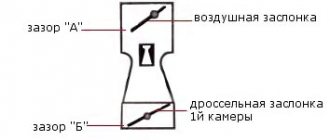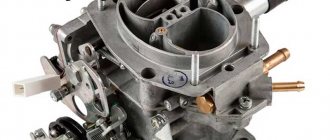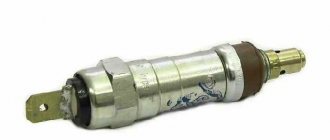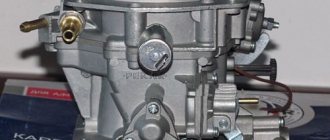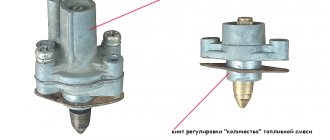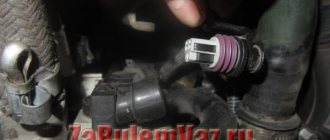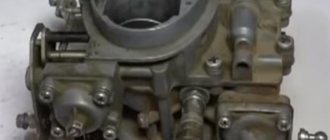Solex carburetors series 21083 are installed on cars equipped with contactless ignition systems. The design of the emulsion-type device has two chambers. The throttle valves are opened sequentially.
The carburetor is equipped with the following systems:
- dosing of both chambers;
- idling of the feather chamber;
- transition of both chambers;
- semi-automatic start;
- diaphragm type accelerator pump;
- economizer modes.
The basic model of the 21083 series has the smallest diffuser diameter and is designed for engines up to 1.5 liters. This carburetor is a universal device. It can be modified for any modification of the power plant by turning the diffusers to the required cross-section.
It is not recommended to install a carburetor on engines with a volume of more than 1.5 liters due to the fact that at high speeds it will “choke” the engine. Since 21083 produces a lean mixture, to increase dynamics on UZAM engines, the jets should be replaced.
A little about the carburetor
This type of carburetor is installed on a car that contains non-contact ignition systems. This device has 2 cameras. The throttle valves open in sequential order.
The carburetor contains a number of specific systems:
- Two chambers go through the dosing stage.
- The feather chamber is equipped with an idle speed.
- Both cameras make the transition.
- Starting occurs semi-automatically.
- Availability of a special accelerator pump. The type of this pump is diaphragm.
- Availability of various economizer modes.
Model 21083 series contains the smallest diffusers in diameter. This model is only suitable for an engine with a volume of no more than one and a half liters. This type of carburetor allows you to install absolutely any improvement in the power plant, if you subject it to certain modifications. The modification will consist in the fact that you will need to machine the diffusers to the cross section you need. This quality makes the carburetor quite versatile.
Note: If your engine has a volume of more than one and a half liters, then installing this type of carburetor is not recommended. This is due to the fact that at a high number of revolutions it will have a bad effect on the engine. Due to the fact that model 21083 produces a rather lean mixture, in order to increase the level of dynamics on the UZAM engine, it is recommended to replace the nozzles.
Jets and accelerator pump
Owners of carburetor cars know that jets change, but they do not always understand why jets are needed and how their size affects the operation of the carburetor. Let's start with the fact that the engine sucks in air through a special hole made in a large diffuser. At the same time, a certain amount of fuel is drawn through the fuel nozzle. The engine displacement directly affects how much air the engine will draw through the diffuser in a certain time, as well as the amount of gasoline sucked in parallel with the air.
Now let's talk about the accelerator pump. The accelerator pump delivers additional fuel when the throttle valve opens, allowing for more efficient acceleration. The pump is activated using a special cam. On engines with a Solex carburetor installed, the indicated accelerator pump cam must be set to the largest one.
You should also pay attention to the so-called “spout” of the accelerator pump. When the valves are opened, fuel should flow in a clear stream and not drip even with a slight throttle opening. It is also important what position the nose occupies. The stream of gasoline must fall exactly into the area between the diffuser wall and the throttle valve, that is, the fuel is jetted directly into the manifold. The jet must not hit the diffuser or damper. If this happens, then after sharply pressing the accelerator pedal the car will not accelerate immediately, and a failure will occur. Self-refinement of the carburetor involves installing two spouts in the chambers to obtain better performance from the engine, or only one spout in the first chamber of the carburetor for a more economical mode.
The process of setting up a Solex carburetor
To adjust the 21083 carburetor for the UZAM engine, you should start by setting a specific level in the float chamber. Level adjustment must be made relative to the lid. To perform this operation, you need to use a special template suitable for your type of carburetor. Such a template is usually found in a special user manual. Without it, you will not be able to complete this task yourself.
After adjusting the float level, you need to make an adjustment for the idle speed.
To do this, you need to perform a number of sequential operations:
- Remove the fully tightened quality screw. It is in the position of approximately 6 turns. When the vacuum in the vacuum hose disappears, you need to stop rotating. This hose is directed to the distributor.
- Check the power plant, which is in a warm state. The test is to see if the engine can maintain idle speed from a thousand to 1500 per minute. If the number of revolutions reaches 800 per minute, then this number should be reduced. To achieve this, you need to additionally unscrew the screw.
- In order to achieve stable operation of your engine, provided that the mixture is as lean as possible, you need to turn the screw more gradually. It is worth understanding that the more the screw is tightened, the leaner the mixture, and therefore CO2 emissions will be minimal.
- For a warm engine, you need to set the idle speed to around 900 per minute. This number is suitable for the summer period of the year. And in winter it will require approximately 1000 rpm.
Depending on the size of your engine, the choice of jet is made. Remember that the larger the engine volume in your car, the less jets are needed.
For the first chamber, a fuel and then an air nozzle are initially selected. After this, jets are selected for another chamber.
Settings
- Remove the minus terminal from the battery and the air filter.
- Slightly open the bolt that secures the linkage to the choke lever.
- Turn the air damper lever until it is completely open.
- In the cabin on the instrument panel there is an air damper drive lever - press it all the way.
- Pull the rod all the way out and tighten the bolt that secures the rod to the air mixture lever.
- Pull the air damper control lever on the instrument panel all the way. If the air damper does not close completely after this, then slightly open the bolt securing the traction cover and, moving the cover, completely close the throttle damper. The bolt can now be tightened.
- Place the minus terminal and filter in place.
Carburetor improvement
If the efficiency of the Solex 21083 carburetor does not suit you, then you can modify it. For this, several different options have been invented. Let's try to look at some of them.
- Adjusting the new level in the float chamber, as well as replacing the valve needle.
This upgrade is done to create more stable carburetor operation. In addition, this will make it possible to stop creating a rather lean mixture at high-power, as well as in transition modes. The needle has a high level of reliability, and it also has high damping characteristics. Thanks to this, the set speed level will be at a more stable level.
- Sawing the throttle valve.
To reduce CO2 emissions, you need to reduce the cross-section of the hole in the throttle valve. Thanks to this action, when driving your car, fuel consumption is reduced by two percent. Another advantage is that when idling, the distribution of fuel among the cylinders will be more uniform.
Specifications
Before we begin to describe the process of refining and increasing the power of the VAZ 2109 carburetor engine, it is worth understanding what power units were installed on the vehicle, and also consider the main technical characteristics.
During the production process, the “nine” was equipped with three options for carburetor engines:
21081 (1.1 8V)
| Name | Index |
| Volume | 1.1 liter (1099 cc) |
| Number of cylinders | 4 |
| Number of valves | 8 |
| Fuel | Petrol |
| Injection system | Carburetor |
| Fuel consumption | 6,7 |
| Cylinder diameter | 76 |
| Cylinder operating order | 1-3-4-2 |
2108 (1.3 8V)
| Name | Index |
| Volume | 1.3 liters (1289 cc) |
| Number of cylinders | 4 |
| Number of valves | 8 |
| Fuel | Petrol |
| Injection system | Carburetor |
| Fuel consumption | 7.0 l |
| Cylinder diameter | 76 |
| Cylinder operating order | 1-3-4-2 |
21083 (1.5 8V)
| Name | Index |
| Volume | 1.5 liters (1499 cm3) |
| Number of cylinders | 4 |
| Number of valves | 8 |
| Fuel | Petrol |
| Injection system | Carburetor |
| Fuel consumption | 7.0 l |
| Cylinder diameter | 76 |
| Cylinder operating order | 1-3-4-2 |
Do-it-yourself Solex carburetor tuning
There are several methods for modifying this carburetor. Most often, tuning is done by boring and grinding various surfaces, as well as smoothing corners. Before the finalization process, it is worth preparing some tools. Such as screwdrivers of various types, items for grinding, a compressor, as well as a special liquid for washing parts.
After you have removed the carburetor and disassembled it, you need to carry out a number of operations:
- Clean carburetor parts.
- Use a file to file off the protruding parts of the screws that are located on the throttle valve.
- Grind off the damper shaft as much as possible.
- The lower part of the carburetor must be thoroughly washed.
- The dampers and their axles need to be pulled out.
- Use a file to round off the B3 axis. After this, you need to tighten the bolts with a cone-shaped head.
- After assembling the entire throttle mechanism, various errors in the initial stamping should be smoothed out.
- Accelerator pump tubes need to be installed in 2 chambers.
- If the mixing chamber has any irregularities, they need to be smoothed out.
Let's summarize: Such carburetor tuning can increase its performance several times.
Content
Carburetors became familiar to everyone with the arrival of VAZ cars on the car market. When creating the VAZ 2109 model, a Solex carburetor was used, which at one time had good performance. The engine could operate correctly under various driving conditions. Considering the features of engine operation, it should be noted that to ensure maximum power, the resistance in the intake tract must be at a minimum level. This moment allows air to penetrate into the combustion chamber in a large volume. When operating at medium and high speeds, in this case, it is possible to achieve high power figures, but the instant opening of the damper reduces the vacuum in the diffuser, and this causes the mixture to become leaner.
Sidebar: Important: Reducing the rate of air filling of the chambers leads to a decrease in power at low speeds. Carburetors, which are installed on VAZ 2109 and 21083 cars, have a main diffuser diameter of 21 mm and 23 mm. This solution makes it possible to enrich the mixture well with air at low speeds, but at the same time the power is reduced at medium and high speeds.
Eliminating air leaks
One of the most common problems is excess air sucking under the carburetor. You can also handle this on your own. To do this, it is necessary to increase the pressing area of the carburetor flange (provided that there is no deformation of the carburetor cover). You will need corner pads (VAZ 2101–2107), in which we drill holes up to 8.2 mm in diameter. Now all that remains is to replace the factory washers with these pads and tighten the nuts.
If the cause of air leaks is a deformed cover, you can replace the factory gasket by making a new one yourself. It can be made from thicker cardboard or other suitable material. Lay a fabric thread along the contour of the gasket and along the contour of the holes and secure it with any gasoline-resistant glue. Grinding the bottom plane of the carburetor cover can also give a good result.
Adjusting the ignition angle
Sluggish acceleration of the car and instability of the idle speed are also often associated with incorrectly set ignition; this procedure is mainly carried out in car repair shops using special equipment. But if you wish, it’s easy to make the adjustment yourself, and without a strobe, and quite accurately:
- with the engine stopped, loosen the three nuts securing the distributor (the third fastening is located at the bottom, it is not visible from above);
- we start the car, turn the distributor-distributor clockwise (to “+”), and if the ignition was late, the idle speed will increase noticeably;
- we select the optimal position of the distributor (the operation of the internal combustion engine should be smooth, without failures), reduce the speed using the quantity screw, turn off the engine, fix the distributor-distributor with one nut for now, and check the results of the ignition adjustment on the fly.
We recommend: How to replace a VAZ-2114 pump with your own hands
If, under heavy load and sharp acceleration, your fingers begin to noticeably “knock” (engine detonation appears), you should move the distributor a little to “minus”, then check the car again while driving. This way you can set the ignition quite accurately, and sometimes even better than with a strobe light.

